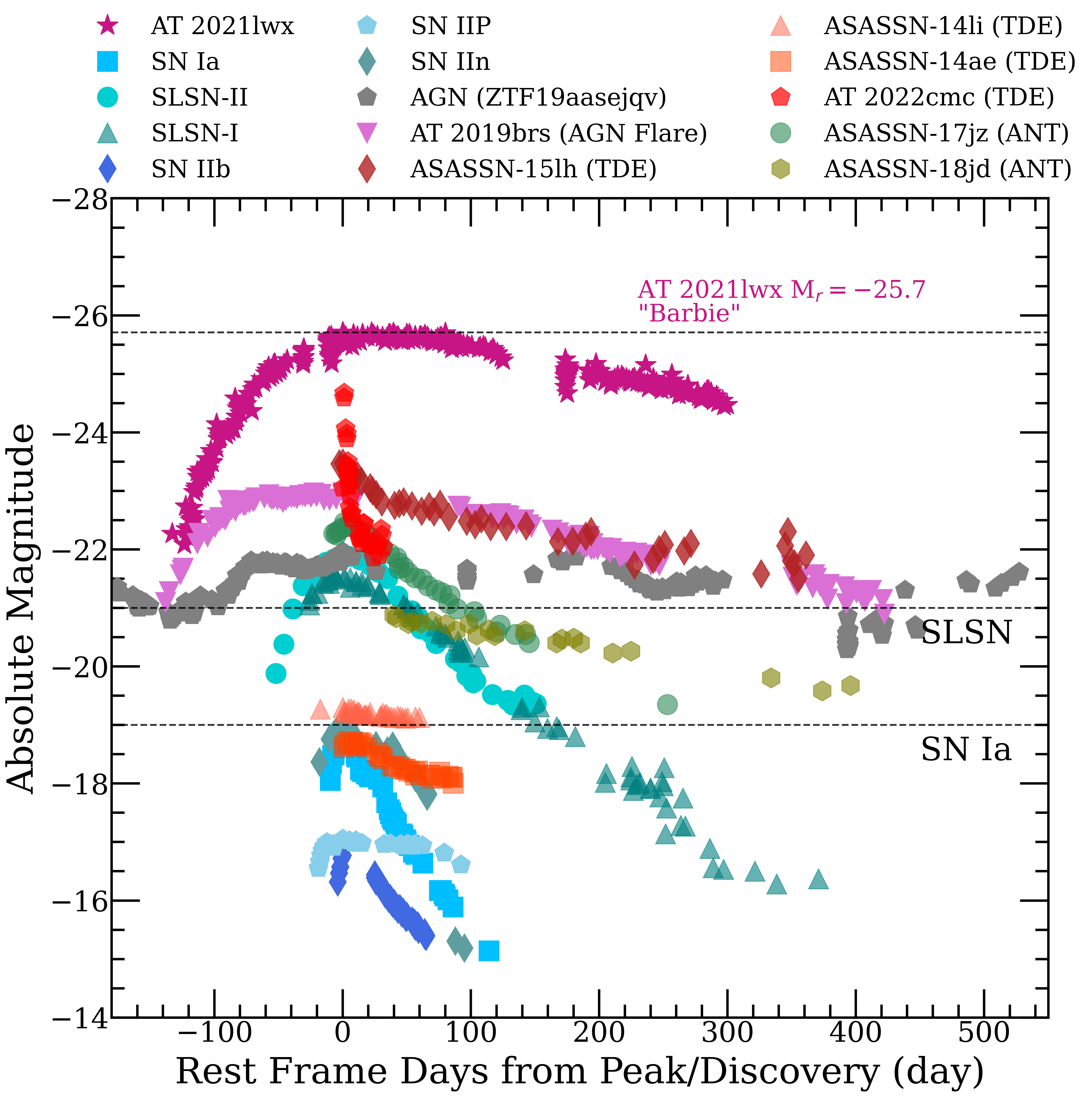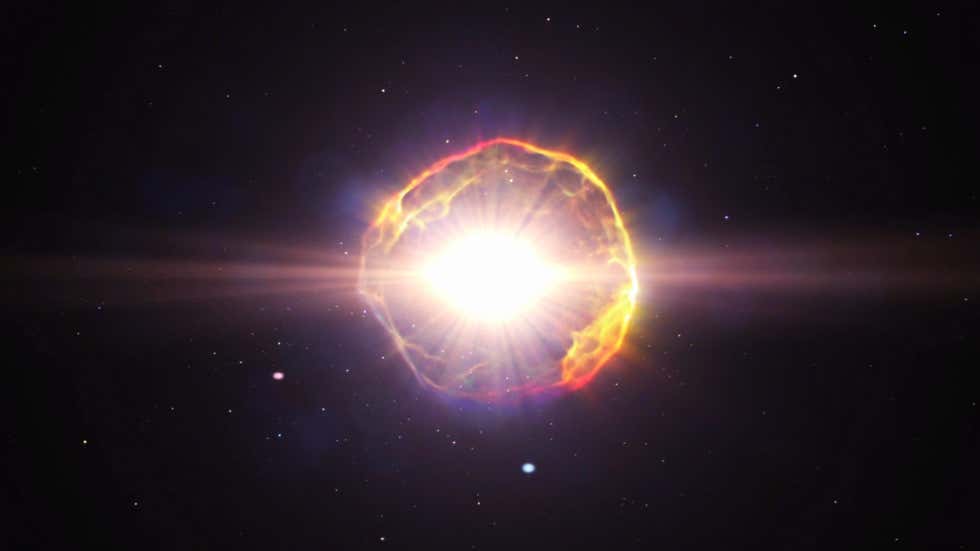Research
Multiwavelength observations and characterization of the ultraluminous transient AT2021lwx (ZTF20abrbeie; aka "Scary Barbie")

Rest-frame ztf-r absolute light curve of AT2021lwx plotted in comparison with other luminous transients (Subrayan+ 2023 )
AT2021lwx (ZTF20abrbeie ; aka "Scary Barbie") is the largest cosmic accretion event ever witnessed. From a spectroscopically measured redshift of 0.995, we reported that AT2021lwx emit a peak-observed pseudo-bolometric luminosity of log(L/[erg/s]) = 45.7 from slowly fading ztf-g and ztf-r light curves spanning over 1000 observer-frame days. Optical spectra exhibit strong emission lines with narrow cores from the H Balmer series and ultraviolet semi-forbidden lines of Si III] λ1892, C III] λ1909, and C II] λ2325. Typical nebular lines in Active Galactic Nucleus (AGN) spectra from ions such as [O II] and [O III] are not detected. These spectral features, along with the smooth light curve that is unlike most AGN flaring activity and the luminosity that exceeds any observed or theorized supernova, lead us to conclude that AT2021lwx is most likely an extreme tidal disruption event (TDE). Modeling of ZTF photometry with MOSFiT suggests that the TDE was between a ≈14 solar mass star and a supermassive black hole of mass ∼ 108 solar masses. No host galaxy for AT2021lwx is detected yet.
Observations of AT 2021lwx originally published in Subrayan+ 2023 can be found here.
Science-Driven Forecasts for Follow-up observations of All-Sky Survey Transients with REFITT

Left: REFITT utilizes grids of core-collapse simulations to make on-the-fly characterizations of transients from the Zwicky Transient Facility (ZTF) all-sky survey. Model parameters (e.g., kinetic energy, mass loss rate, ,56Ni mass, ejecta mass) can then be used to guide decision-making based on scientific objectives. Right: Follow-up observations of Type II event ZTF22aaacxkp at valuable epochs (shown in diamonds) in multiple filters by observing agents at Supra Solem Observing (SSO) using recommendations provided by REFITT (Subrayan+ 2023).
The Recommender Engine for Intelligent Transient Tracking (REFITT) is an artificial intelligence system that prioritizes and recommends follow-up observations of transients based on science-driven objectives such as characterizing key explosion parameters (Sravan+ 2020). Theoretically-driven forecasts of transients can be leveraged to strategize follow up observations to optimally achieve scientific objectives from all-sky surveys. Prioritizing the underlying physics of transients will make it possible to 1) rapidly recognize transients of desired physical parameter spaces, and 2) identify information-rich epochs in transient evolution for efficient follow-up with limited facilities. Subrayan+ 2023 demonstrated that pre-computed hydrodynamical model grids (Moriya+ 2023) along with statistical analyses can provide opportunities to enhance scientific return from all-sky surveys that provide live alert streams. Hence, real-time characterization of transients can be incorporated into TOMs to make forecasts that can efficiently recommend targets for follow-up at information-rich epochs.
The JWST Survey of Supernova Remnant Cassiopeia A

JWST Mid-Infrared Instrument (MIRI) composite image of the supernova remanant Cassiopeia A (Red: 25.5 microns (F2550W), Orange-red: 21 microns (F2100W), Orange: 18 microns (F1800W), Yellow: 12.8 microns (F1280W), Green: 11.3 microns (F1130W), Cyan: 10 microns (F1000W), Light blue: 7.7 microns (F770W), and Blue: 5.6 microns (F560W))
Supernova remnants provide crucial insights into the mechanisms of stellar explosions and the characteristics of their progenitor systems. By studying their structure, composition, and dynamics, we gain a deeper understanding of the physical processes involved in these cataclysmic events. I am associated with Cycle I JWST proposal (PI: Danny Milisavljevic) to conduct photometric and spectroscopic observations of the supernova remnant Cassiopeia A. The observations with JWST will utilize its unique capabilities to directly compare shocked and un-shocked ejecta to current SN models, constrain properties of shocked SN dust, and investigate the nature of Cas A's central compact object, informing neutron star evolution models.
Constraining the Progentitor Systems and Explosion Mechanisms of Stripped-Envelope Supernovae (SESN)

The increased sensitivity of the upcoming large-scale all-sky surveys, can detect transients very early in their evolution providing unique platforms to understand their progenitor systems (e.g : shock breakout emission from stripped-envelope supernovae (SESNe)). The larger sample of such events with early detections from these surveys can be used to statistically place constraints on their environments and explosion properties. In this project, I intend to study the shock breakout and cooling envelope emission of SNe IIb that are flagged by REFITT from all-sky surveys. The study can provide upper limits or ranges for the compactness of the progenitor of these explosions. This analysis can be further investigated on other types of SESNe, and can be used to quantify what fraction of SESNe would exhibit a cooling emission phase in their evolution.
